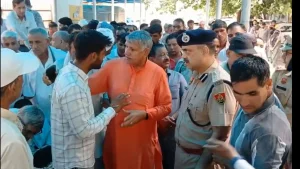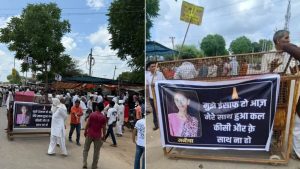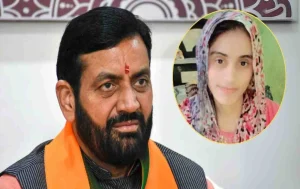Haryana – The tragic Manisha Case Haryana has evolved into a major political and social crisis as protesters continue demanding justice for the murdered 19-year-old play school teacher. Opposition parties, social activists, and grieving family members have gathered in Bhiwani’s Dhigawa village, maintaining their demonstration for three consecutive days while refusing to claim the victim’s body until arrests are made.
The Manisha Case Haryana has exposed serious lapses in police response and investigative procedures, leading to widespread criticism of state authorities and demands for immediate accountability. The incident has become a rallying point for political opposition and civil society organizations questioning the current administration’s commitment to women’s safety.
Timeline of Events and Police Response Failures

The Manisha Case Haryana began unfolding on August 11 when Manisha was last seen leaving her school in Singhani village at 1:58 PM. She had planned to visit a nearby private nursing college to inquire about admission to a B.Sc nursing course, with CCTV footage confirming her presence near the college that afternoon.
However, the Manisha Case Haryana investigation faced immediate obstacles when police initially refused to register a missing persons report. Manisha’s father, Sanjay Singh, alleged that Loharu police dismissed his concerns on August 11, suggesting his daughter might have run away or gone on a trip and would return within a few days.
The delayed response in the Manisha Case Haryana proved fatal, as a missing complaint was only registered the following day. Two days later, on August 13, Manisha’s body was discovered in Singhani village fields with her throat slit, transforming the missing person case into a murder investigation.
Road Blockade and Public Demonstrations


Public anger over the Manisha Case Haryana reached a crescendo when protesters blocked the Delhi-Pilani road, calling for immediate justice for the victim. The road blockade lasted nearly two hours before police intervention convinced demonstrators to lift the obstruction, though protests continued at the village level.
The sustained demonstrations surrounding the Manisha Case Haryana reflect deep community frustration with police handling of the investigation. Family members and supporters have maintained their vigil, refusing to perform final rites until perpetrators are arrested and brought to justice.
The Manisha Case Haryana protests have drawn support from across political lines, with various party representatives joining family members in demanding swift action against those responsible for the young teacher’s murder.
Evidence Tampering Allegations and Institutional Failures
The Manisha Case Haryana has raised serious questions about potential evidence tampering and institutional cooperation. The victim’s family has accused the nursing college management of withholding crucial evidence that could aid the investigation.
Also Read: Tragic Shock: Engineering Student in Greater Noida Takes Own Life, 1 Suicide Note Found
According to family allegations in the Manisha Case Haryana, when police visited the nursing college seeking CCTV footage, staff members refused to provide the recordings until August 13. This delay has fueled suspicions about potential cover-up attempts and institutional non-cooperation with law enforcement.
The evidence handling concerns in the Manisha Case Haryana have intensified criticism of both police procedures and institutional accountability, with family members questioning whether crucial investigative opportunities were deliberately compromised.
Political Response and Government Criticism
Opposition leaders have seized upon the Manisha Case Haryana to criticize the current BJP administration’s law and order record. Jannayak Janata Party youth president Digvijay Chautala questioned police capabilities, stating that despite Haryana police’s reputation for solving complex cases, they have failed to identify suspects even after five days.
Indian National Lok Dal leader Sunaina Chautala framed the Manisha Case Haryana as evidence of government failure to deliver justice to poor families, demanding immediate criminal apprehension. Her criticism highlights broader concerns about economic inequality in access to justice.
Congress leader Raju Mann characterized the Manisha Case Haryana as symptomatic of “jungle raj” conditions in Haryana, suggesting criminals operate parallel governments. This rhetoric reflects opposition attempts to frame the incident within broader governance failures.
Government Defense and Administrative Actions
State Irrigation Minister Shruti Choudhry defended government handling of the Manisha Case Haryana, citing swift administrative measures including suspension of five police officers and transfer of Bhiwani SP. She assured protesters that Chief Minister Nayab Singh Saini committed to ensuring perpetrators face justice.


The administrative response to the Manisha Case Haryana includes disciplinary actions against police personnel, suggesting acknowledgment of procedural failures. However, critics argue these measures address symptoms rather than systemic problems in law enforcement.
Aam Aadmi Party’s national media in-charge Anurag Dhanda condemned the Manisha Case Haryana handling as evidence of complete law and order collapse in Haryana, joining the chorus of political criticism directed at state authorities.
Investigation Progress and Medical Findings
Singhani sarpanch Sanjeet Kumar provided updates on the Manisha Case Haryana investigation, reporting that SP Sumit Kumar informed local officials about new leads suggesting the case would be solved soon. This represents the first official acknowledgment of potential breakthrough developments.
Medical examination results in the Manisha Case Haryana revealed disturbing details about the victim’s condition. Dr. Balwan Singh, principal medical officer at Bhiwani civil hospital and autopsy team member, reported that Manisha’s skin showed damage suggesting partial animal attack, adding complexity to the investigation.
Family’s Steadfast Demand for Justice
The Manisha Case Haryana continues generating public attention as the victim’s father maintains his vow not to cremate his daughter’s body until arrests are made. Sanjay Singh directly blamed police negligence for his daughter’s death, arguing that timely action could have prevented the tragedy.
This unprecedented stand in the Manisha Case Haryana demonstrates the family’s determination to achieve justice while highlighting their loss of faith in institutional processes. Their refusal to perform final rites serves as a powerful symbol of protest against perceived systemic failures in protecting women and delivering justice.

